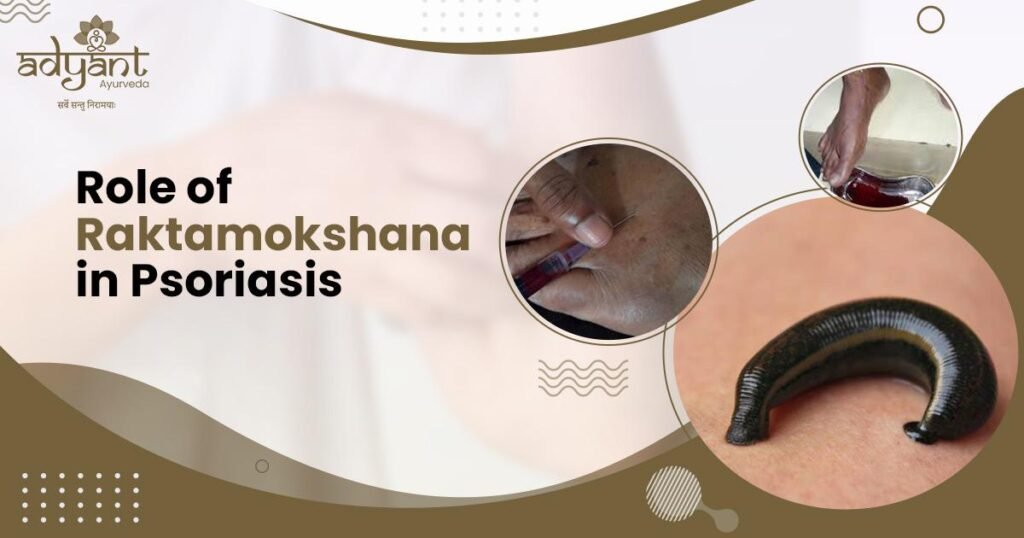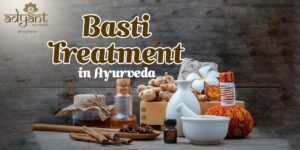INTRODUCTION
Psoriasis is a skin-related immune-compromised condition that results in hyper proliferation of the skin. Here will discuss about Role of Raktamokshana in Psoriasis. The term psoriasis originated from a Greek word, psora- itch.
WHAT IS PSORIASIS?
As per ayurveda, psoriasis is a skin-related condition which is caused due to intake of virudha ahara dravyas, by following virudha vihara which is a common chronic inflammatory multisystem disease seen over the skin.
WHAT ARE THE CAUSES OF PSORIASIS?
-Intake of virudha aharas i.e., mutually contradictory foods like fish with milk, taking cow’s ghee and honey in an equal quantity, mixing honey with a warm water, etc.
–Intake of curd at night: As curd is abhishyandi in nature and night is kapha predominant kala, it will block channels in the body leading to stagnation of fluids in the body and due to this it develops the infection.
–Intake of food when not hungry: taking food over when previously taken food is still not digested will lead to agni mandhya. When there is no proper digestion, absorption and assimilation take place, which leads to the accumulation of toxins inside our body leading to skin issues.
–Intake of uncooked or not properly cooked food: if food is not cooked properly it will stay for a long in the stomach as it takes a long time to get digested and sometimes it won’t get properly digested which again leads to the accumulation of toxins.
–Sudden exposure from heat to the cold environment: when an individual gets exposed from sudden high temperature to low temperature, it will dry up the skin and causes itching.
–Intake of hot and cold items together: like for example nowadays people take ice cream with hot chocolate which includes hot and cold items taken simultaneously, it is mutually contradictory in nature.
–Suppressing natural urges: by suppressing urges like vomiting, thirst, and motion toxins get accumulated in the body. it is better to let it out when there is an urge.
–Stress and anxiety: by taking excess stress and anxiety it releases certain hormones which again leads to disturbance in hormonal levels.
This will occur when there is immune-compromised condition or some will get carried over with genes.
WHAT ARE THE SIGNS AND SYMPTOMS OF PSORIASIS?
– Shyava varna: blackish brown discolouration of the skin.
– Kinakharasparsha: affected area will be rough to touch, it will be like a scar tissue.
– Parusha: hard on touch
– kandu: itching
– sometimes there will be a whitish powdery discharge.
– sometimes there will be a burning sensation.
As per ayurveda, doshas that are predominantly involved in psoriasis are vata & kapha.
It will be localised and more predominantly seen in certain areas like the scalp, nails, palms and soles. Later if left untreated it will spread to the surrounding areas.
The scalp will be the first site of involvement in up to 25% of psoriasis treatment. It is often seen between 15yrs to 40 yrs.
Initially, it appears as a small bump or a papule sub-mounted by a scale. When papules get connected to each other – a papule is formed which is covered by a thick layer of horny scale.
When this scale sheds, it appears as a powdery dandruff. Scratching plaques either because of itching will make it really worse.
WHAT IS THE AYURVEDIC TREATMENT FOR PSORIASIS?
Ayurveda is a holistic medicine which heals through natural substances. In combination with panchakarma therapy, herbal medicine, dietary changes & lifestyle modifications can give relief from psoriasis.
PANCHAKARMA IN PSORIASIS
Depending upon the doshas involved panchakarma will be planned accordingly.
-In vata predominant condition, Basti will be given.
-In pitta predominant condition, virechana along with Rakthamokshana will be planned.
-In Kapha predominant condition, Vamana will be planned.
-Rakthamokshana can be planned for almost all types of skin-related diseases and for psoriasis as blood will be infected with the accumulation of toxins in most cases.
WHAT IS THE ROLE OF RAKTHAMOKSHANA IN PSORIASIS?
-Rakthamokshana helps in purifying the blood by removing dushta raktha i.e., blood infected with toxins. It is considered Ardha Chikitsa in shalya tantra(surgery) as it can be taken as a line of treatment for most blood-related diseases.
There are 4 types of blood-letting treatment
-
- Siravyadha (vein puncture)
-
- Jalauka (leech therapy)
-
- Shrunga (using cow’s horn)
-
- Alabhu (like cupping)
In psoriasis, jalauka and siravyadha can be done near the affected area.
Siravyadha (Vein puncture): it is considered superior among other types of rakthamokshana.
Pre procedure – patient’s haemoglobin, clotting time, and bleeding time have to be tested before taking patient has to be made to drink snighda yavagu (unctuous gruel) just 10 mins before the treatment to make them stable as blood-letting might cause giddiness in some individuals. Have to check vitals like bp, pulse, and heart rate before puncturing the vein. Keep a glass of sugar and salt mixed water ready.
Procedure – the patient has to be made to sit or lie down based on the site of the vein puncture, if a person is sitting give him/her support to the back while sitting. Cover the patient’s eyes using a cloth. Keep monitoring the patient’s BP. Select a prominent vein near the affected area, and tie a tourniquet just above the selected area to puncture the vein. Inform the patient before puncturing the vein and give a bold prick at a 45-degree angle, as soon as the blood starts coming out start collecting it in a jar.
Post-procedure – after removing the needle, keep lodhra churna in place and proper pressure bandaging has to be done. Ask the patient whether he/she is feeling dizzy, if yes make him/her drink salt and sugar water. Make them sit and rest for at least 15 mins.
Things to be observed during sira vyadha -if blood is coming out with much force, that means dushta vata dosha is coming out, if blood is coming out not too fast not slow that says dushta pitta dosha is coming out and if blood is coming out is a very slow pace is says dushta kapha is being expelled out.
The maximum amount of blood that can be let out is one prastha(~600 ml) in a balina (person having full strength).
Bloodletting has to be done based on the amount of doshas accumulated and by seeing the strength of a person.
As dushta doshas get eliminated from the body, blood gets purified, in this way, further progress of the disease can be prevented and existing inflammation and other symptoms will also get reduced.
To know more about the role of raktamokshana in psoriasis or for psoriasis treatment, consult our team of expert doctors at Adyant ayurveda.







